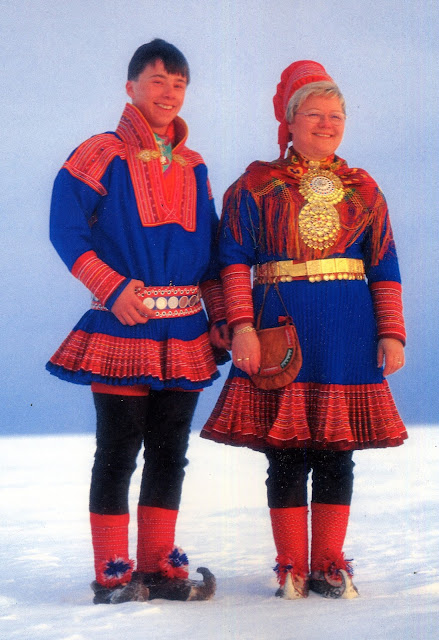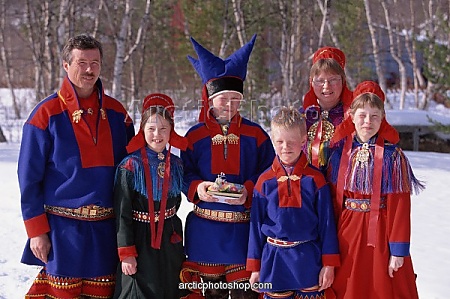Hello all,
Today I will do an overview of the costumes of the Saami people. Previously they were called Lapps, but this is not what they call themselves, and they consider the term to be pejorative. The origin of the word Lapp is controverted, but it may be from Old Finnish/Estonian for a place far away.
The Land of the Saami; Sápmi, Sábme, or Saemie, depending on the Dialect, is split between four nation-states, Norway, Sweden, Finland, and Russia. It consists of the northern part of the Fenno-Scandian peninsula.
The Saami do not have political recognition as a people, but they do have a flag.
The colors of the flag are the same colors used in Saami costume, for the most part.
Linguists group the various Saami dialects into 9 Languages, of which 3 are moribund. These languages are completely unrelated to Norwegian, Swedish or Russian, and only distantly related to Finnish. There are about 160,000 Saami worldwide, of which maybe 20,000 speak one of their native languages. In spite of this linguistic diversity, they do indeed think of themselves as one people, and recently have been very active politically. For more information see these articles.
There are a large number of blogs and articles online as well.
I will be following the linguistic groups in my discussion of the costumes. Here are two maps which show the different groups. The second one omits the three moribund languages, but has many useful place names. I will be referring to both groups and locations throughout the article. Saami languages were also once spoken much further south.
This second map lumps some of the groups together:
1 Southern Saami
2 Central Saami
3. Northern Saami
4 Inari Saami
5 Skolt Saami
6 Kola Saami
The term which the Saami use for their costume is Gákti. This has been borrowed into Norwegian as Kofte, into Swedish as Kolt, and into Finnish as Takki. There is no equivalent in Russian.
The couple at the head of the article are wearing the costume which is the most famous, from Kautokeino (Guovdageaidnu) in Norway. [Throughout this article I will give the internationally recognized name of a location first, followed by the Saami name in parentheses.] This is undoubtedly the poster child of the Saami group, being one of the most colorful and impressive. Most of the Gákti have the same basic construction, however. The main part of the costume consists of a pullover, which is basically the same for men and women, the mens' version hangs about mid thigh, while the womens' hangs to the knee or mid calf, depending on the local variation. The following drawings by Max Tilke show the basic cut. The first is a woman's garment from 'Tornelappmark', which is an old name for far northern Sweden.
This is a man's garment, place of origin unspecified.
This shows a pair of pants and a variety of different hats and bonnets used by the Saami.
The basic garment is belted with either a woven sash or leather strap, which may be variously ornamented.
Men wear pants, and women also in cold weather; low boots with woven straps are worn, some of plain leather and others of reindeer fur. Reindeer fur leggings are worn in winter over the pants, these sometimes have 'wings' attached to the upper edge. Hats and bonnets vary greatly according to location. The basic color of the cloth is usually the blue of the Saami flag, but it may be black, off-white, or sometimes green. Garment pieces may also be of leather. The trim is almost always red and yellow, with some green added at times. Overgarments of reindeer fur are worn in winter.
DMC has put out a book titled 'Lapland Embroideries', but NONE of the embroidery designs pictured in the book are Saami. There are a couple of designs from the woven sashes on p. 40, but the rest of the designs are from various other northern peoples ranging from the Icelanders to the Nanai.
The Saami do not traditionally do embroidery as such. They do a lot of applique and patchwork on their costumes, and they do a type of metal couching using pewter wire. This is commonly done on belts, and on the bags which hang from the belt, and are also done on the dickey which is worn under the main garment in many Saami costumes. Here are a couple examples of this work,
In the eastern parts of Sabme, beadwork is also done. In this image, the two woven sashes are Northern Saami from Enontekiö (Eanodat) in Finland, and the beaded one is Skolt Saami.
I will now give short illustrations of the costumes of the various groups. This will by no means be exhaustive, as there are many regional types, and detailed information is difficult to find on some of them. Please refer to the above maps.
SOUTH SAAMI
There are about 2000 South Saami, of whom perhaps 600 can speak the language.
Here is the costume from between Femunden and Saltfjellet in Norway.
A closeup of the dickey, pin, purse and belt of this costume. Notice the pewter wire couching.
This costume is from around Idre in Dalarna, Sweden.
This young man is also South Saami from Sweden, from around AmmarnäsTärnaby, VilhelminaÅsele.
The central Saami traditionally spoke the Ume, Pite and Lule languages, going from south to north. Ume Saami currently has about 10 speakers, and Pite Saami has between 25 and 50. There are more who no longer speak the language.
So many good sources of images do not bother to record the exact origin, so many of the images which I have are simply marked 'Sweden' or 'Norway'. I have not been able to find many images of these people.
Ume Saami
This is the only image which I have been able to find which is unequivocably Ume Saami. This woman is LenaMaria Nilsson who is active in Saami politics.
Pite Saami
Lule Saami
Lule Saami is still spoken by perhaps 2000 people, the second largest of the Saami languages.
A Lule Saami couple from Tysfjord Norway
Lule Saami from Jokkmokk (Jåhkåmåhkke or Dálvvadis) in Sweden
NORTHERN SAAMI
The Northern Saami are found in the northernmost parts of Norway, Sweden, and Finland.Theirs is the largest of the Saami languages at 15,000 or more speakers. There are districts where they are still the majority population.
There are a dozen or more very colorful costumes worn by the Northern Saami I will highlight just a few.
Sweden:
Jukkasjärvi (Čohkkirasjávri)
Norway
These are some of the Northern Saami costumes found in Norway.
Troms (Romsa)
Varanger (Várnjárga)
Karasjok (Kárášjohka)
The same basic costume is also worn in Tana. You can see the 'wings' on the fur leggings on the man.
Kautokeino ( Guovdageaidnu)
This is often described as 'embroidered', but in fact the ornamentation consists of rows of appliqued patterned ribbon.Finland
The costumes of Enontekiö (Eanodat) are basically the same as in Kautokeino (Guovdageaidnu)
Sodankylä (Soađegilli)
Utsjoki (Ohcejohka)
INARI SAAMI
The Inari and Skolt languages are each highly divergent from the other Saami languages.
About 300 people currently speak this language, although there is a movement to start teaching it to younger people. The Inari only live in Finland.
SKOLT SAAMI
The Skolt Saami number about 1250 and live in Norway, Finland and Russia, although most of the 400 speakers of the language live in Finland.Some of them abandoned the Gáktii for chemise and Sarafan as worn by their neighbors, The Karelians and the White Sea Russians.
The women wear beaded caps which are similar to the Sorokka worn by the Karelians.
KOLA SAAMI
These only live in Russia. Of the three languages, Akkala is extinct, and 2 people still speak Ter. Kilden Saami is still spoken by perhaps 600 people. It is not used much in daily life, and most Saami in Russia do not speak it.
I have found several images of Saami from Russia, but I do not have information as to which costume comes from which location. Some of these may be Skolt.
Here is one blog which is devoted to Saami culture. This is well worth looking over for more information and links.
I have pieced this article together from many sources, and while I have caught some obvious errors, there may be others which have found their way into this article. I am particularly unsure concerning the material from Sweden. If anyone, Saami or otherwise notices such errors, I apologize and would greatly appreciate better information and images. Thank you.
Feel free to contact me with requests for research. I hope to eventually cover all of Europe and the Former Russian Empire/Soviet Union. I also gratefully accept tips on source materials which i may not have. I also accept commissions to research/design, sew, and/or embroider costumes or other items for groups or individuals. I also choreograph and teach folk dance.
Roman K.
Source Material:
Ulf Hård af Segerstad, 'Dakkan En Bok om Samernas Slöjd', Malmö, Sweden, 1971RolfKjellström et al, 'Saami Daaidda', Helsinki, 1981Heidi Fossnes, 'Norges Bunader og Samiske Folkedrakter', Oslo, 1994
Liv Trotzig et al, 'Sockendräkter Dalarna', Dalarna, 1976
Natalia Kalashnikova et al, 'National Costumes of the Soviet Peoples', Moscow, 1990
L. N. Molotova, 'Folk Art of the Russian Federation', Leningrad, 1981
Max Tilke, 'East European Costumes', London, 1926
Charles Holme, ed., 'Peasant Art in Sweden, Lapland, and Iceland', London, 1910
Much of this material I found online, I thank all those who make such information available. Upon request I will include explicit sources of the images. Thank you





































































